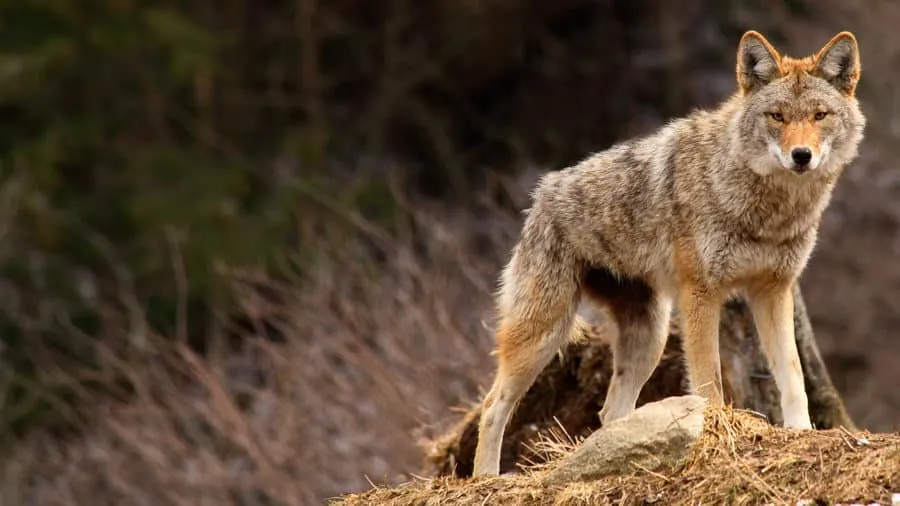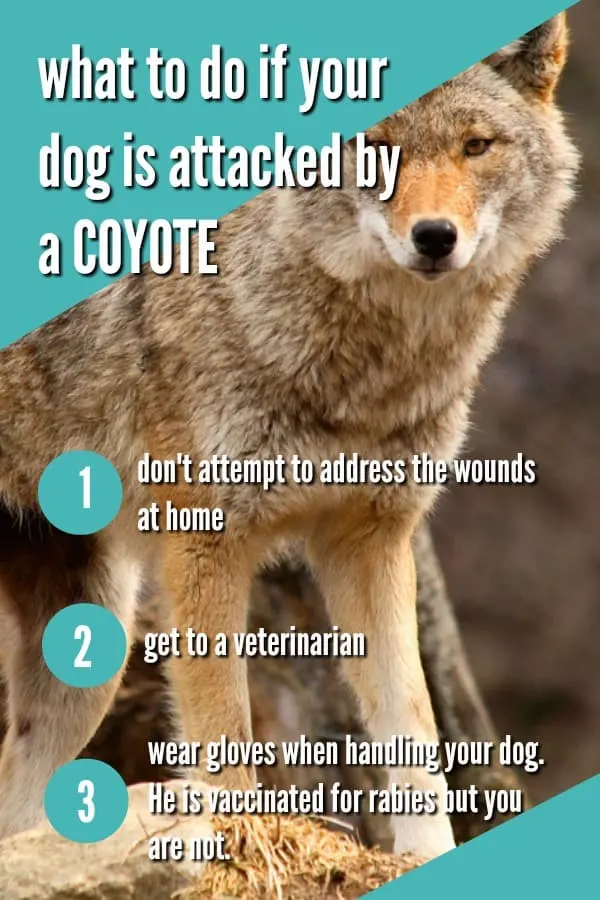
Today we have a guest post from the Texas A&M University College of Veterinary Medicine & Biomedical Sciences with advice on what to do if your dog gets bitten by a coyote–and how you can take steps to prevent coyotes and other wildlife from interacting with your dog.
Living in the country, coyotes are a fact of life for us–and I worry about coyote attacks. We hear coyotes in the evenings and at night (and any time they hear a siren). We see evidence of them on every dog walk.
But we do our best to make sure our dogs have no close interaction with the coyotes. We walk our dogs on leash and have had a few encounters with coyotes on our walks–but with the dogs right at my side, I didn’t worry about their safety as I would have if they’d been off leash.
I carry pepper spray and citronella spray in my dog walking bag.
And we work to keep our yard unattractive to coyotes, with no food, trash or dog waste to lure them inside.
But what if, even after our best efforts, one of our dogs got in a scuffle with a coyote?
Let’s see what the experts have to say about this important topic in the guest post below:
Protect Your Pets From Coyotes And Other Wild Animals
Although most wild animals mind their business and don’t bother humans, some wild animals, such as coyotes, can wander into human environments and cause harm to pets.
“It’s pretty amazing how much damage coyotes can do to pets, especially when you consider that coyotes are roughly the size of a domestic dog,” said Christine Rutter, a clinical assistant professor at the Texas A&M College of Veterinary Medicine & Biomedical Sciences. “Coyotes are very effective predators. Pets that come to our emergency room after a coyote attack often have severe injuries.”
What to do if your dog is attacked by a coyote
Because coyote bites have the potential to cause severe body and organ damage, Rutter recommends that every pet that is attacked by a coyote, bobcat, or an unknown animal be evaluated by a veterinarian as soon as possible.
Owners should not attempt to address wounds at home.
A bite from a wild animal also poses another threat—the spread of potential diseases, such as rabies.
“We don’t often think of the coyote as a major vector of rabies, but it is possible,” Rutter said. “However, the most common carriers for rabies are raccoons, skunks, foxes, and bats.
“Thankfully, most pets have had a recent rabies vaccination, which will protect them from this virus,” she said. “However, saliva in the pet’s wounds can expose people who are not commonly vaccinated for rabies to the virus. I always recommend that owners wear gloves when handling pets that have been attacked by a wild or potentially unvaccinated animal.”
Steps to protect your dog from coyote attacks
While humans might not be able to control the behavior of wild animals, pet owners can take steps toward protecting pets from potential attacks.
“Coyotes and other wild animals thrive in urban and suburban environments due to the availability of food and shelter provided by people,” Rutter explained. “It seems that the only thing we can really do is to limit access to these resources. I recommend that people secure food sources, including trash, compost, outdoor pet food, and wildlife feeders. I would also be sure that outbuildings are secure and don’t make comfortable homes for wildlife.”
Since many wild animals, including coyotes, are most active from dusk till dawn, keeping pets safe during this time is crucial.
“Keeping pets indoors during this time seems the most obvious choice, but it’s not realistic in some situations,” Rutter said. “I recommend that pets be limited to a fenced area or leash walked.
“I would also have a good outdoor light, visually check the yard, and make a bit of noise before pets are allowed outside.
“Especially at night, it’s important to supervise your pets when they are outside. Pets of any size can find trouble, but pets under 50 pounds are especially vulnerable.”
If your pet primarily resides outdoors, a completely enclosed kennel with a roof may also be an effective way to keep unwanted visitors out.
“Ventilation holes in the kennel should be small enough to keep out any animal larger than a rat, and the kennel should be large enough that the confined animal should be able to at least stand up, turn around, and escape any water accumulation on the floor,” Rutter said.
Webcams and security systems can also help you monitor your yard at both day and night.
We can’t predict the behavior of wild critters, but we can take steps to lessen the chance that our pet comes in contact with a dangerous animal.

- Review: Jimmy BX7 Pro Anti-Mite Vacuum Cleaner - December 16, 2024
- 🎉 GIVEAWAY: Lord of the Pets Portrait of Your Dog! - November 26, 2024
- Review: Lord of the Pets Portraits - November 17, 2024
